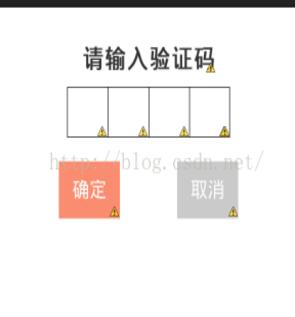在用到支付类或者验证类app时,都有一个简密的输入框。百度了下有个不错的帖子,点击打开链接
不过自己也写了个简单的类似的。

懒得运行,直接截layout.xml的效果图先。
布局文件
<RelativeLayout xmlns:android="http://schemas.android.com/apk/res/android" android:layout_width="fill_parent" android:layout_height="wrap_content" android:background="#ffffff" android:paddingBottom="20dp" android:paddingTop="30dp" > <TextView android:id="@+id/txtTitle" android:layout_width="wrap_content" android:layout_height="wrap_content" android:layout_centerHorizontal="true" android:text="请输入验证码" android:textStyle="bold" android:textSize="22sp" /> <LinearLayout android:id="@+id/layout" android:layout_width="wrap_content" android:layout_height="wrap_content" android:layout_below="@+id/txtTitle" android:layout_centerHorizontal="true" android:layout_marginTop="10dp" android:orientation="horizontal" > <TextView android:id="@+id/t1" android:layout_width="wrap_content" android:layout_height="wrap_content" android:background="@drawable/i1" android:gravity="center" android:inputType="number" android:lines="1" android:maxLines="1" /> <TextView android:id="@+id/t2" android:layout_width="wrap_content" android:layout_height="wrap_content" android:background="@drawable/i1" android:gravity="center" android:inputType="number" android:lines="1" android:maxLines="1" /> <TextView android:id="@+id/t3" android:layout_width="wrap_content" android:layout_height="wrap_content" android:background="@drawable/i1" android:gravity="center" android:inputType="number" android:lines="1" android:maxLines="1" /> <TextView android:id="@+id/t4" android:layout_width="wrap_content" android:layout_height="wrap_content" android:background="@drawable/i2" android:gravity="center" android:inputType="number" android:lines="1" android:maxLines="1" /> </LinearLayout> <EditText android:id="@+id/editHide" android:layout_width="wrap_content" android:layout_height="wrap_content" android:layout_alignBottom="@+id/layout" android:layout_alignLeft="@+id/layout" android:layout_alignRight="@+id/layout" android:layout_alignTop="@+id/layout" android:layout_weight="1" android:background="#00000000" android:cursorVisible="false" android:ems="10" android:inputType="number" android:maxLength="4" android:textColor="#00000000" /> <LinearLayout android:layout_width="wrap_content" android:layout_height="wrap_content" android:layout_below="@+id/layout" android:layout_centerHorizontal="true" android:layout_marginTop="20dp" > <Button android:id="@+id/verifycode_ok" android:layout_width="wrap_content" android:layout_height="wrap_content" android:background="#fa8d70" android:layout_marginRight="30dp" android:textColor="#ffffff" android:text="确定" /> <Button android:id="@+id/verifycode_cancel" android:layout_width="wrap_content" android:layout_height="wrap_content" android:layout_marginLeft="30dp" android:background="@color/index_time_but" android:textColor="#ffffff" android:text="取消" /> </LinearLayout> </RelativeLayout>
代码:
import android.app.Activity; import android.os.Bundle; import android.text.Editable; import android.text.TextWatcher; import android.widget.EditText; import android.widget.TextView; public class MainActivity extends Activity { TextView t1, t2, t3, t4, et; String key = ""; @Override protected void onCreate(Bundle savedInstanceState) { super.onCreate(savedInstanceState); setContentView(R.layout.verifycode); t1 = (TextView) findViewById(R.id.t1); t2 = (TextView) findViewById(R.id.t2); t3 = (TextView) findViewById(R.id.t3); t4 = (TextView) findViewById(R.id.t4); et = (EditText) findViewById(R.id.editText1); et.addTextChangedListener(tw); } void setKey() { char[] arr = key.toCharArray(); t1.setText(""); t2.setText(""); t3.setText(""); t4.setText(""); for (int i = 0; i < arr.length; i++) { if (i == 0) { t1.setText(String.valueOf(arr[0])); } else if (i == 1) { t2.setText(String.valueOf(arr[1])); } else if (i == 2) { t3.setText(String.valueOf(arr[2])); } else if (i == 3) { t4.setText(String.valueOf(arr[3])); } } } TextWatcher tw = new TextWatcher() { @Override public void onTextChanged(CharSequence s, int start, int before, int count) { } @Override public void beforeTextChanged(CharSequence s, int start, int count, int after) { } @Override public void afterTextChanged(Editable s) { key = s.toString(); setKey(); } }; } 好哒,就这样了,运行就有效果了。没有什么自定义,没有什么第三方。
当然。如果你要弹窗形式的话,也一样,加下面的就能弹窗了
final AlertDialog dialog = new AlertDialog.Builder(mContext).create(); dialog.show(); dialog.getWindow().setContentView(R.layout.verifycode);t1 = (TextView) dialog.findViewById(R.id.t1); t2 = (TextView) dialog.findViewById(R.id.t2); t3 = (TextView) dialog.findViewById(R.id.t3); t4 = (TextView) dialog.findViewById(R.id.t4);
后期有时间再补上项目DOME。
以上就是本文的全部内容,希望对大家的学习有所帮助,也希望大家多多支持VEVB武林网。
注:相关教程知识阅读请移步到Android开发频道。